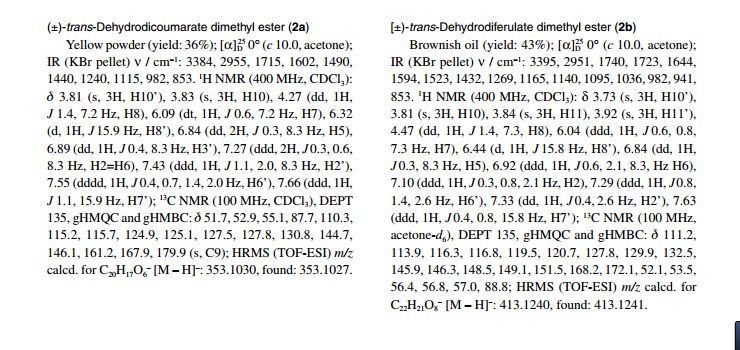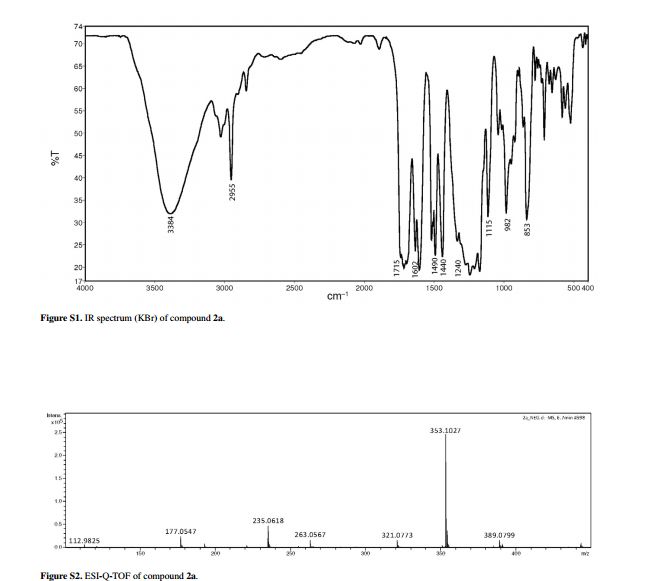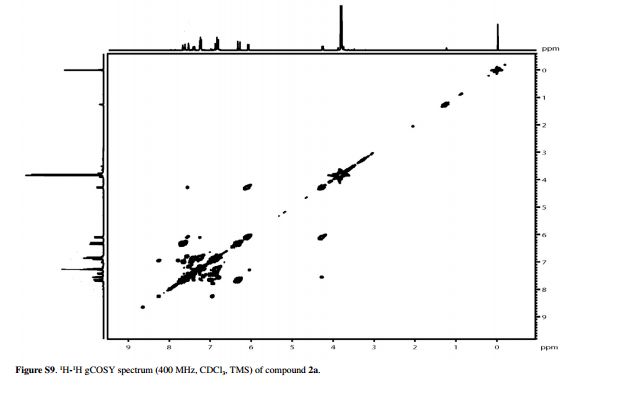Figure 1 Structures of dihydrobenzofuran neolignans 2a and 2b.
Scheme 1 (i) Ag2O, (CH3)2CO:C6H6 3:5, r.t., 20 h (2a: 36% yield; 2b: 43% yield).
Figure 3 Main nuclear Overhauser effect (NOE) correlations observed in the nuclear Overhauser effect spectroscopy (NOESY) spectra of compounds 2a and 2b.
Table 1 1H and 13C NMR data assignments for compound 2a (400 MHz, CDCl3)
| δCa | δH (integral, multiplicityb), J/ Hz | |
|---|---|---|
| 1 | 132.0 (C) | − |
| 2=6 | 127.5 (CH) | 7.27 (2H, ddd, J2,5 = J6,3 0.3, J2,7 = J6,7 0.6, J2,3 = J6,5 8.3) |
| 3=5 | 115.7 (CH) | 6.84 (2H, dd, J3,6 = J5,2 0.3, J3,2 = J5,6 8.3) |
| 4 | 156.1 (C) | − |
| 7 | 87.7 (CH) | 6.09 (1H, dt, J7,2 = J7,6 0.6, J7,8 7.2) |
| 8 | 55.1 (CH) | 4.27 (1H, dd, J8,6′ 1.4, J8,7 7.2) |
| 9 | 170.9 (C) | − |
| 10 | 52.9 (CH3) | 3.83 (3H, s) |
| 1′ | 127.8 (C) | − |
| 2′ | 130.8 (CH) | 7.43 (1H, ddd, J2′,7‘ 1.1, J2′,6′ 2.0, J2′,3′ 8.3) |
| 3′ | 110.3 (CH) | 6.89 (1H, dd, J3′,6′ 0.4, J3′,2′8.3) |
| 4′ | 161.2 (C) | − |
| 5′ | 125.1 (C) | − |
| 6′ | 124.9 (CH) | 7.55 (1H, dddd, J6′,3′ 0.4, J6′,7′ 0.7, J6′,8 1.4, J6′,2′2.0) |
| 7′ | 144.7 (CH) | 7.66 (1H, ddd, J7′,6′ 0.7, J7′,2′ 1.1, J7′,8′ 15.9) |
| 8′ | 115.2 (CH) | 6.32 (1H, d, J8′,7′ 15.9) |
| 9′ | 167.9 (C) | − |
| 10′ | 51.7 (CH3) | 3.81 (3H, s) |
aMultiplicities assigned on the basis of distortionless enhancement by polarization transfer (DEPT) 135 experiments;
bmultiplicities and coupling constant values measured within 1H NMR and J-resolved spectra with the help from1H-1H correlation spectroscopy (COSY) results.
Table 2 2D NMR data for compound 2a (400 MHz, CDCl3)
| C | H | gCOSYa | gHMBCb | gHMQCc | NOESYd |
|---|---|---|---|---|---|
| 1 | – | – | H3 =H5, H7, H8 | – | – |
| 2=6 | 2=6 | H3, H5, H7 | H3 =H5, H7 | H2=H6 | H7, H8 |
| 3=5 | 3=5 | H2, H6 | H5 | H3=H5 | – |
| 4 | – | – | H3 =H5, H2 =H6 | – | – |
| 7 | 7 | H2=H6, H8 | H6, H8 | H7 | H2=H6* |
| 8 | 8 | H7, H6′ | H7, H6′ | H8 | H2=H6, H6′* |
| 9 | – | – | H7, H8, H10 | – | – |
| 10 | 10 | – | − | H10 | – |
| 1′ | – | – | H3′, H8′ | – | – |
| 2′ | 2′ | H3′, H6′, H7′ | H6′, H7′ | H2′ | H7′, H8′* |
| 3′ | 3′ | H2′, H6′ | − | H3′ | – |
| 4′ | – | – | H2′, H3′, H6′, H7, H8 | – | – |
| 5′ | – | – | H8, H3′ | – | – |
| 6′ | 6′ | H2′, H3′, H7′, H8 | H2′, H7′, H8 | H6′ | H8′, H7′, H8* |
| 7′ | 7′ | H2′, H8′, H6′ | H2′, H6′, H8′ | H7′ | H6′*, H2′ |
| 8′ | 8′ | H7′ | H7′ | H8′ | H6′*, H2′ |
| 9′ | – | – | H7′, H8′, H10′ | – | – |
| 10′ | 10′ | – | – | H10′ | – |
bgradient-selected heteronuclear multiple bond coherence;
cgradient-selected heteronuclear multiple quantum coherence;
dnuclear Overhauser effect spectroscopy.
*mean weak correlation.
aGradient-selected correlation spectroscopy;
Table 3 1H and 13C NMR data assignments for compound 2b (400 MHz, acetone-d6)
| δCa | δH (integral, multiplicityb); J/ Hz | |
|---|---|---|
| 1 | 132.5 (C) | – |
| 2 | 111.2 (CH) | 7.10 (1H, ddd, J2,5 0.3, J2,7 0.8, J2,6 2.1) |
| 3 | 149.1 (C) | – |
| 4 | 148.5 (C) | – |
| 5 | 116.3 (CH) | 6.84 (1H, dd, J5,2 0.3, J5,6 8.3) |
| 6 | 120.7 (CH) | 6.92 (1H, ddd, J6,7 0.6, J6,2 2.1, J6,5 8.3) |
| 7 | 88.8 (CH) | 6.04 (1H, ddd, J7,6 0.6, J7,2 0.8, J7,8 7.3) |
| 8 | 57.0 (CH) | 4.47 (1H, dd, J8,6′ 1.4, J8,7 7.3) |
| 9 | 172.1 (C=O) | – |
| 10 | 53.5 (CH3) | 3.81 (3H, s) |
| 11 | 56.4 (CH3) | 3.84 (3H, s) |
| 1′ | 129.9 (C) | – |
| 2′ | 113.9 (CH) | 7.33 (1H, dd, J2′,7′ 0.4, J2’6′ 2.6) |
| 3′ | 146.3 (C) | – |
| 4′ | 151.5 (C) | – |
| 5′ | 127.8 (C) | – |
| 6′ | 119.5 (CH) | 7.29 (1H, ddd, J6′,7′ 0.8, J6′,8 1.4, J6′,2′ 2.6) |
| 7′ | 145.9 (CH) | 7.63 (1H, ddd, J7′,2′ 0.4, J7′,6′ 0.8, J7′,8′ 15.8) |
| 8′ | 116.8 (CH) | 6.44 (1H, d, J8′,7′ 15.8) |
| 9′ | 168.2 (C) | – |
| 10′ | 52.1 (CH3) | 3.73 (3H, s) |
| 11′ | 56.8 (CH3) | 3.92 (3H, s) |
aMultiplicities assigned on the basis of distortionless enhancement by polarization transfer (DEPT) 135 experiments;
bmultiplicities and coupling constant values measured within 1H-NMR and J-resolved spectra with the help from1H-1H correlation spectroscopy (COSY) results.
Table 4 2D NMR data for compound 2b (400 MHz, acetone-d6)
| C | H | gCOSYa | gHMBCb | gHMQCc | NOESYd |
|---|---|---|---|---|---|
| 1 | – | – | H2, H6, H7, H8 | – | – |
| 2 | 2 | H5, H6, H7 | H5, H6, H7 | H2 | H7, H8, H11 |
| 3 | – | – | H2, H5, H11 | H3 | – |
| 4 | – | – | H2, H5, H6 | – | – |
| 5 | 5 | H2, H6 | H6 | H5 | – |
| 6 | 6 | H2, H5, H7 | H2, H5 | H6 | H7, H8 |
| 7 | 7 | H2, H6, H8 | H2, H6, H8 | H7 | H6*, H2 |
| 8 | 8 | H6′, H7 | H2, H6′ | H8 | H6′*, H2, H6 |
| 9 | – | – | H7, H8, H10 | H9 | – |
| 10 | 10 | – | − | H10 | – |
| 11 | 11 | – | − | H11 | H2 |
| 1′ | – | – | H7′, H8′ | H1′ | – |
| 2′ | 2′ | H6′, H7′ | H6′, H7′ | H2′ | H7′, H8′*, H11′ |
| 3′ | – | – | H11′ | – | – |
| 4′ | – | – | H2′, H6′, H7, H8 | – | – |
| 5′ | – | – | H7, H8′ | – | – |
| 6′ | 6′ | H7′, H2′, H8 | H2′, H7′, H8 | H6′ | H8′, H7′, H8* |
| 7′ | 7′ | H2′, H6′, H8′ | H2′, H6′, H8′ | H7′ | H6′, H2′, |
| 8′ | 8′ | H7′ | H7′ | H8′ | H6′, H2′ |
| 9′ | – | – | H8′, H10′ | – | – |
| 10′ | 10′ | – | – | H10′ | – |
| 11′ | 11′ | – | – | H11′ | H2′ |
aGradient-selected correlation spectroscopy;
bgradient-selected heteronuclear multiple bond coherence;
cgradient-selected heteronuclear multiple quantum coherence;
dnuclear Overhauser effect spectroscopy.
*mean weak correlation.
1H and 13C NMR data previously reported for compound2a and 2b were obtained in CDCl3 or acetone-d6. Most of the signals in the 1H NMR spectrum were between δH 6.0 and δH 8.0, but the hydrogen signal multiplicities are ambiguous. In this work, we found that for compound2a in acetone-d6, the signals at δH 7.6-7.7 are referred to four hydrogen atoms and their overlapping precluded their correct assignment (Figure 2). Therefore, CDCl3 provided much clearer spectra for 2a, but not for 2b, due to the solvent influence on chemical shifts. For compound 2b, three hydrogen atoms resonate at δH 6.91 in the 1H HMR spectrum in CDCl3. On the other hand, the 1H NMR signals of 2b were resolved by using acetone-d6 as solvent, which allowed verification of the multiplicities, observation of the chemical shifts and measurement of the coupling constants.
Journal of the Brazilian Chemical Society
On-line version ISSN 1678-4790
J. Braz. Chem. Soc. vol.27 no.1 São Paulo Jan. 2016
http://dx.doi.org/10.5935/0103-5053.20150262
ARTICLES
Detailed 1H and 13C NMR Spectral Data Assignment for Two Dihydrobenzofuran Neolignans
aDepartamento de Química, Faculdade de Filosofia, Ciências e Letras de Ribeirão Preto, Universidade de São Paulo, 14040-901 Ribeirão Preto-SP, Brazil
bNúcleo de Pesquisas em Ciências Exatas e Tecnológicas, Universidade de Franca, 14404-600 Franca-SP, Brazil
cDepartment of Chemistry and Biochemistry, Utah State University, 84322-0300 Logan-UT, United States
ABSTRACT
In this work we present a complete proton (1H) and carbon 13 (13C) nuclear magnetic resonance (NMR) spectral analysis of two synthetic dihydrofuran neolignans (±)-trans-dehydrodicoumarate dimethyl ester and (±)-trans-dehydrodiferulate dimethyl ester. Unequivocal assignments were achieved by 1H NMR, proton decoupled 13C (13C{1H}) NMR spectra, gradient-selected correlation spectroscopy (gCOSY), J-resolved, gradient-selected heteronuclear multiple quantum coherence (gHMQC), gradient-selected heteronuclear multiple bond coherence (gHMBC) and nuclear Overhauser effect spectroscopy (NOESY) experiments. All hydrogen coupling constants were measured, clarifying all the hydrogen signals multiplicities. Computational methods were also used to simulate the 1H and 13C chemical shifts and showed good agreement with the transconfiguration of the substituents at C7 and C8.
Key words: neolignans, oxidative coupling, J-resolved, benzofurans
see……….0103-5053-jbchs-27-01-0136-suppl01.pdf
//////////////




















Sorry, the comment form is closed at this time.